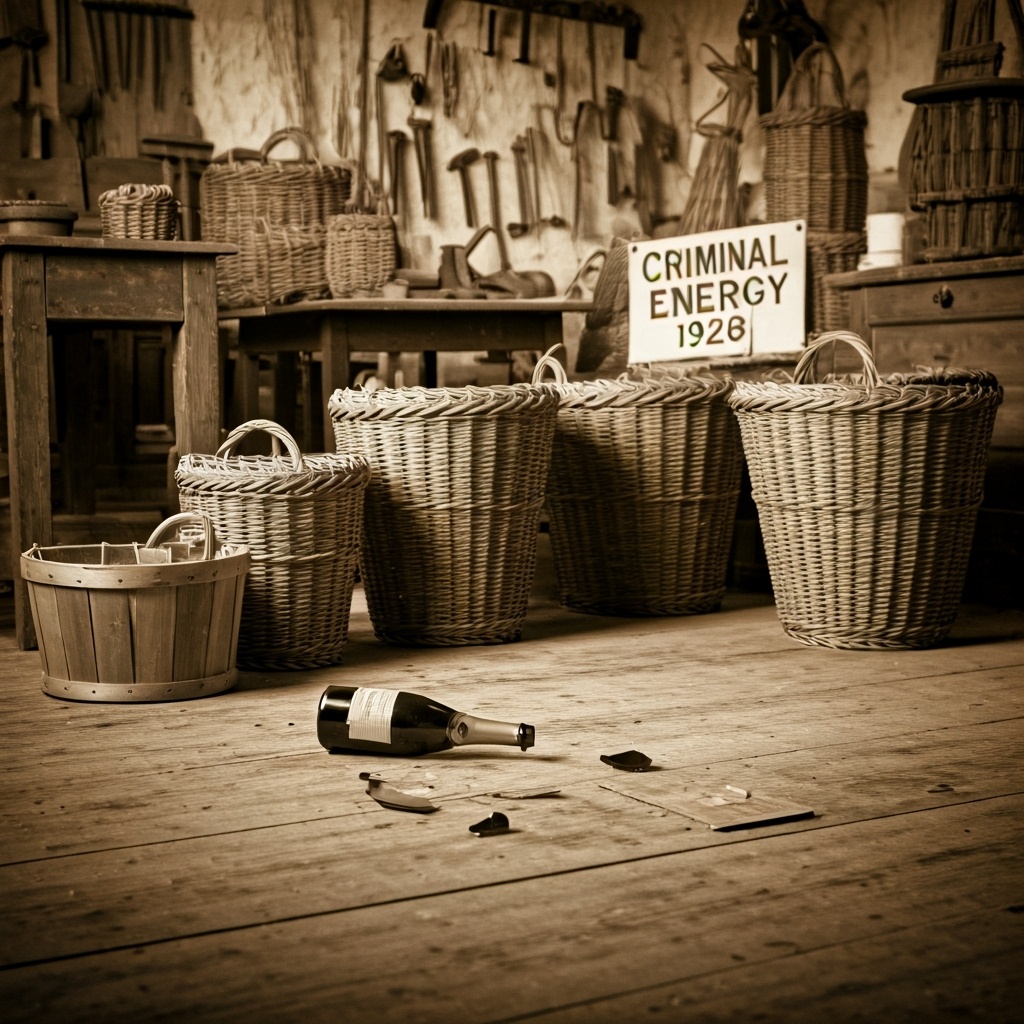October 31, 1928, was a day of horror in the small village of Glannes. Albert Clarisse, a wandering basket maker and rabbit trader, entered the tavern of the widow Foucault with sinister intentions. The 68-year-old owner could not have known that her brave decision to defend her property against theft would cost her her life. The scene took place in the tavern’s cellar, where Clarisse acted in the heat of the moment. Without thinking twice, he grabbed an empty champagne bottle and smashed it with all his might onto the widow’s head, shattering her skull with a horrific crack. But that wasn’t enough: to ensure that no witnesses remained, Clarisse grabbed his serpe—a tool he used for his basket weaving work—and decapitated the widow in cold blood. However, this act was just another page in a tragic book of crimes committed by Clarisse. Two years earlier, on September 29, 1926, he had once again unleashed his darkness in Orconte. This time, the victim was the elderly widow Hamiez, an innocent 89-year-old woman. Clarisse knocked the old lady down and assaulted her before stealing her meager fortune of 25 francs. This criminal act led to a terrible miscarriage of justice in which a mentally impaired villager named André Rémy was wrongfully convicted and sent to prison. Thanks to later confessions and revelations from Clarisse’s lover and accomplice Lisa Karl, the truth was brought to light and the innocent man was given his freedom back after far too many years in prison. Albert Clarisse joined the long list of criminals who will stop at nothing to achieve their selfish goals. The peaceful village of Glannes suffered the consequences of these brutal events, but somehow life found its way back to normal. In the same idyllic village, there is still a charming inn and a lovingly run hotel. Nothing reminds us of the dark days when bottles were not used to enjoy fine champagne, but served as deadly weapons. The story of a crime often begins with the choice of weapon. Experienced criminals have their favorite instruments: the knife, the revolver. Beginners, on the other hand, usually resort to tools they use in their everyday work. The butcher has his sharp knife, the winegrower his pruning knife, and the lumberjack his axe. Albert Clarisse, the wandering basket weaver and rabbit dealer, grabbed whatever came to hand. And so fate took its course. Step by step, the police investigation revealed the macabre puzzle of Clarisse’s deeds. His barbaric treatment of the old women shocked the community deeply. But the truth, painful as it was, had to come to light. The streets and squares of Glannes suddenly became the scene of intense investigations and discussions. Slowly but surely, all the pieces were put together until the whole picture of these cruel crimes emerged and clarity prevailed about the culprit. At the end of the investigation, the role of Lisa Karl was also examined. Her confessions were crucial in breaking the chain of misunderstandings and freeing the innocent people from their suffering. It was not only the revelation of Clarisse’s incomprehensible atrocities, but also a bitter lesson about the deceptive nature of trust in the justice system. Ultimately, Albert Clarisse was executed in May 1930. Despite this dark past, Glannes remains a place of tranquility and beauty. Its picturesque landscapes and charming buildings continue to attract visitors who enjoy the serenity of a charming village. Who would have thought that this peaceful setting was once the scene of such barbaric crimes? Forgetting is certainly a human ability, but history always leaves its mark. So, while Glannes is now considered one of the many examples of the idyllic lifestyle of the French countryside, behind this façade lies a deeply rooted and complex history. The memory of the victims and the innocent people who suffered remains alive and reminds us to be vigilant and compassionate. Albert Clarisse may be long gone, but his deeds are part of the collective memory of Glannes. While visitors happily enjoy their champagne, it is a silent reminder of the dark chapters that once took place here. You no longer need to break bottles on heads to appreciate the value of this precious drink—every bottle tells a story, and some stories are more disturbing than others. Here’s to the truths that come to light and to the hope that such times will never return.
By Isabella Mueller
Welcome to my journey through creativity and discovery! My name is Isabella Mueller, and I invite you to explore the fascinating creative universes I create through my blogs. Since 2020, I have been dedicating my passion to telling captivating stories that are mysterious, historical, and emotional. My goal is not only to entertain, but also to inspire reflection and awaken the spirit of discovery in each of us. At isabellas.blog, the suspense of crime stories is combined with exciting travel tips. Imagine wandering through the picturesque streets of a new city, uncovering dark secrets hidden in the shadows of its history. Every piece on my blog is designed to make the heart of every crime fiction fan beat faster while sparking curiosity about unknown places. Here, you are invited to experience the thrill of the unknown and the beauty of our world—a perfect combination for all adventure seekers! My second blog, akteq.com, is all about true, unsolved crime stories. Under the motto “akteQ: Cold Case Stories,” I reveal the eerie and often tragic stories behind unsolved cases. Together, we can explore the mysteries of the past and delve deep into the human psyche. What really happened? Who were the people behind these mysterious events? In this blog, I invite you to ask questions and find the answers that often remain hidden in the dark. You can find another exciting chapter in my blogging career at thecastles.org. Here, I embark on an enchanting journey through the history of castles and palaces. Pause for a moment as you discover the stories hidden within the walls of these ancient structures. “Explore the enchantment, discover the history – your journey begins at thecastles.org!” These words are more than just a slogan; they are an invitation to anyone who wants to combine history and magic. Be inspired by the impressive stories and the fascination of bygone eras! But that's not all! At kripo.org, you'll find a comprehensive online magazine for real criminal cases. Immerse yourself in the world of crime, learn about the real stories behind the headlines and the people who are involved in solving them. With criminal.energy, I take you on a journey through the gripping stories of true crimes in which villains are hunted, caught, and convicted. The search for justice and the confrontation with the unknown are at the center of it all. TrueCrime Blog 187.news takes you into the depths of crime. And for those who want to travel the world, wanderlust.plus offers the opportunity to explore the world, one adventure at a time. It's all about the love of exploration and the joy of discovering new cultures and landscapes. Finally, truecrime.ch invites you to discover the dark side of Switzerland and Europe: true crimes, true stories. Let's discover together the stories that shape the world around us. I look forward to accompanying you on this exciting journey and hope you will share many unforgettable moments with me!

